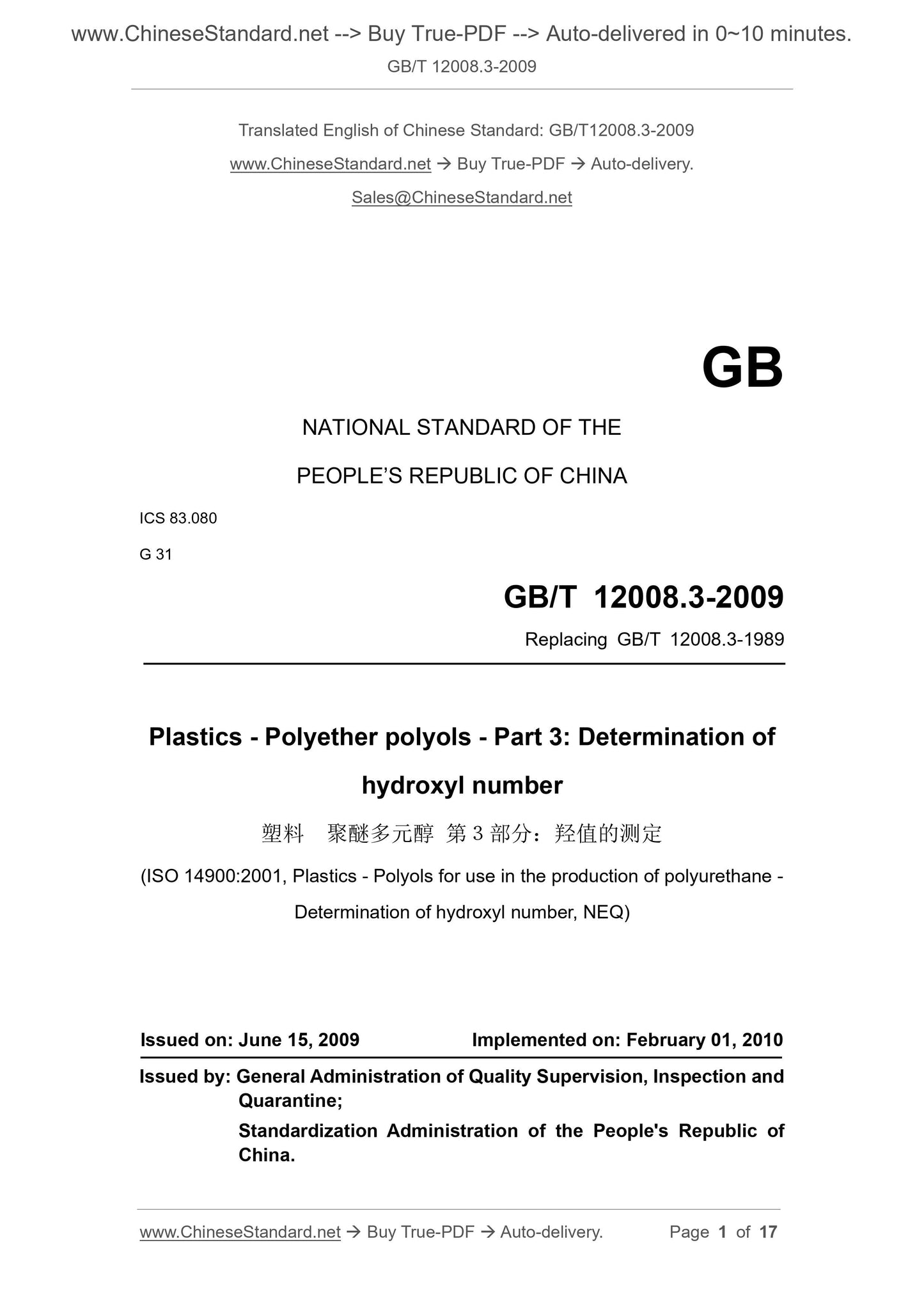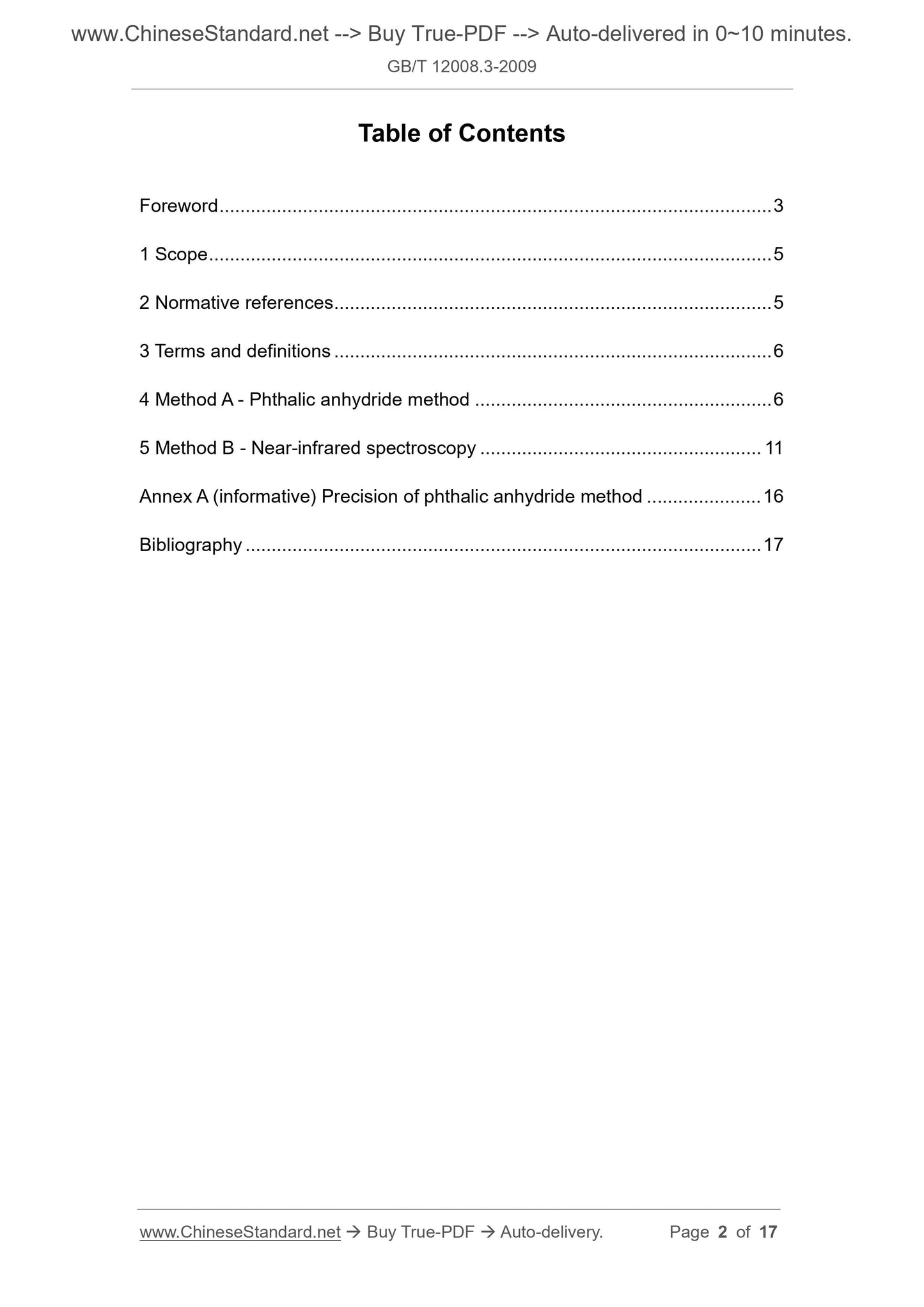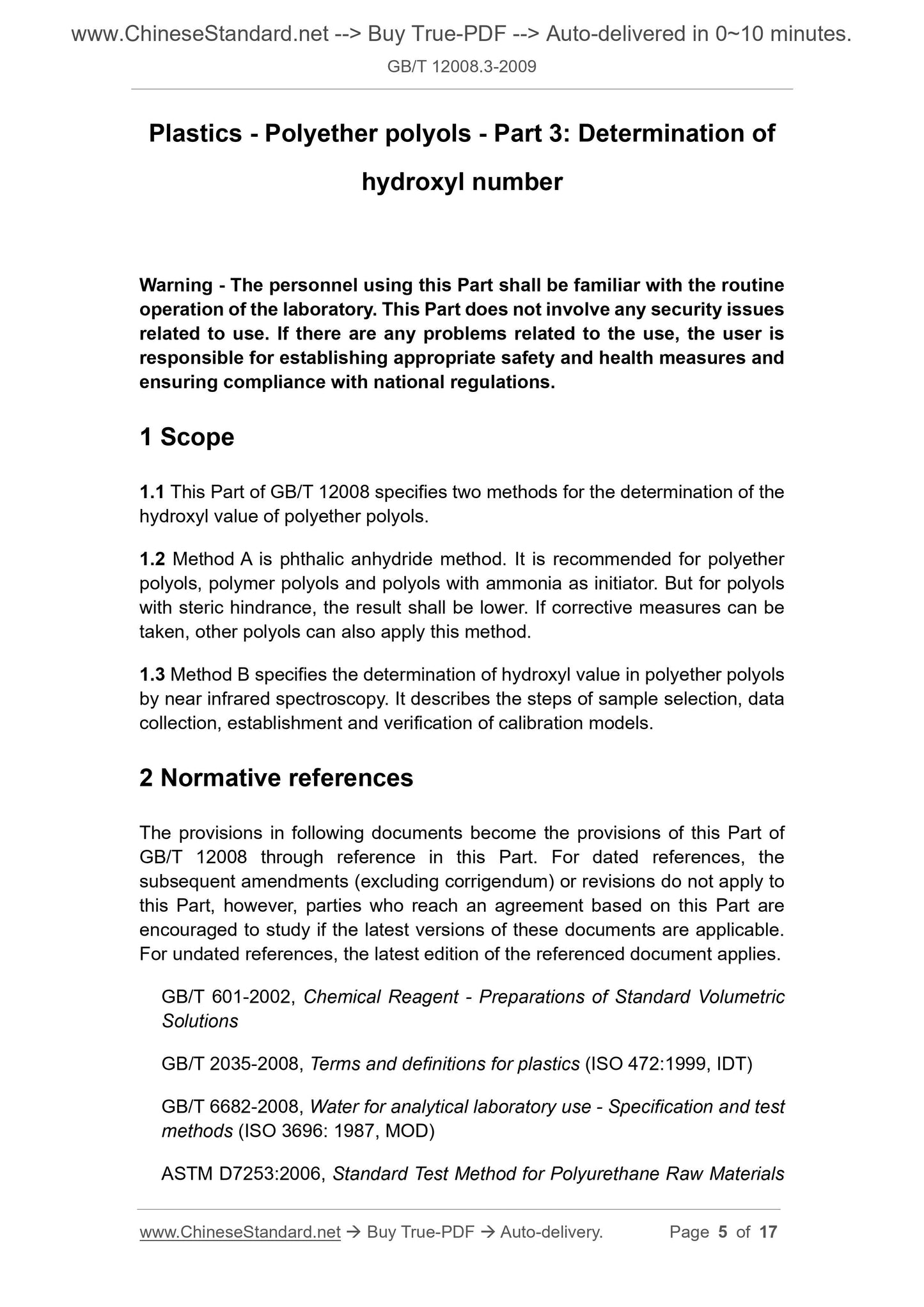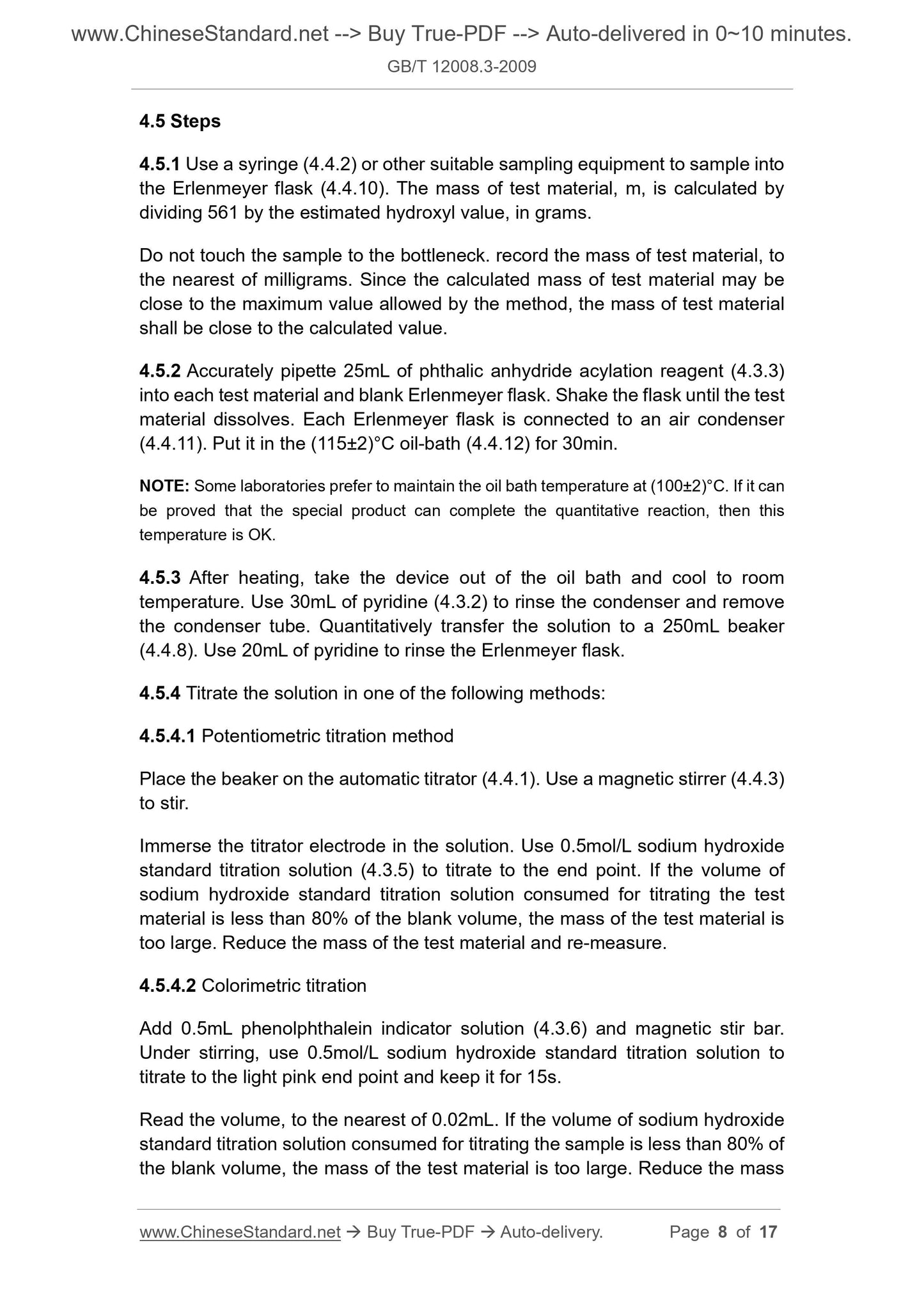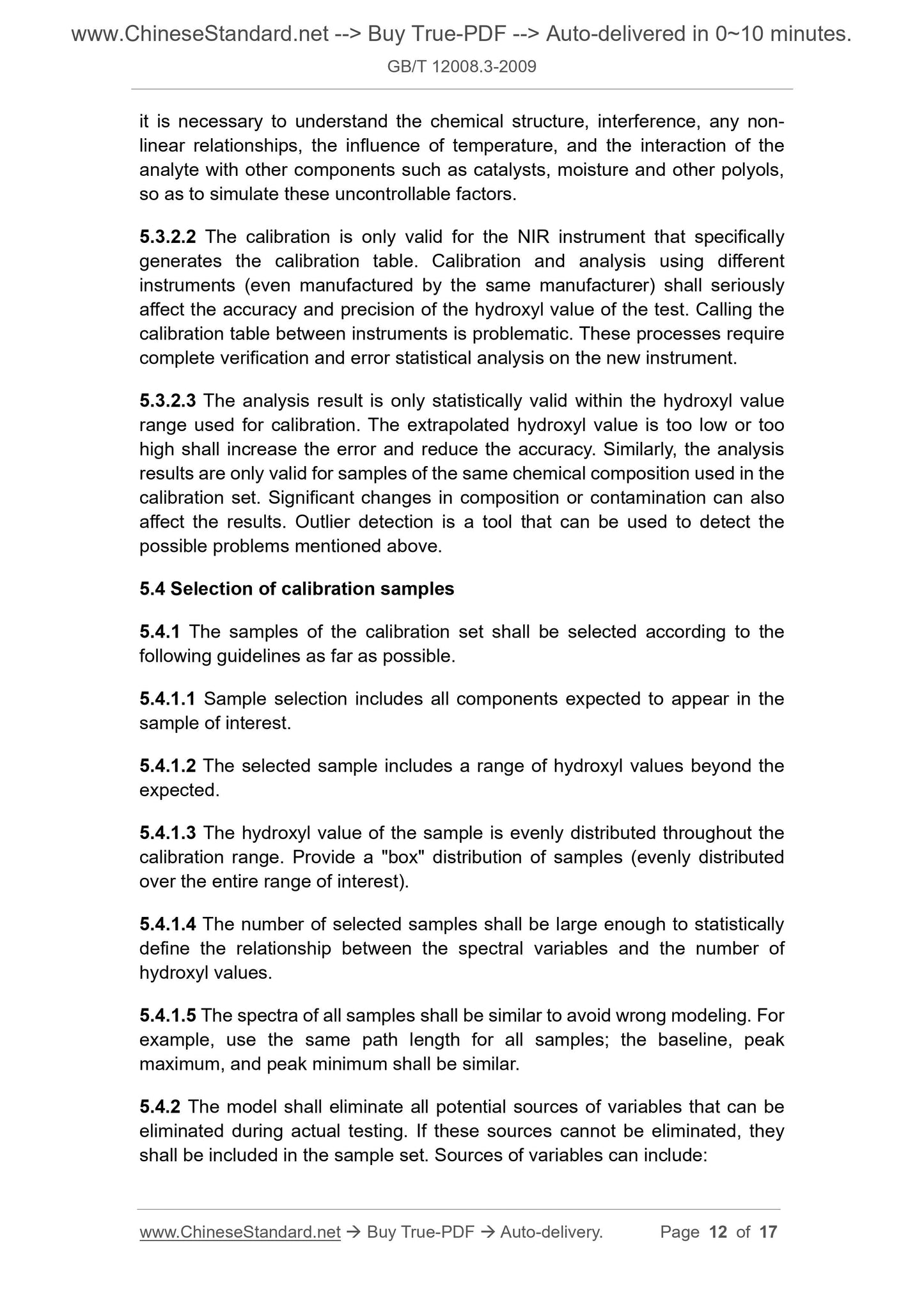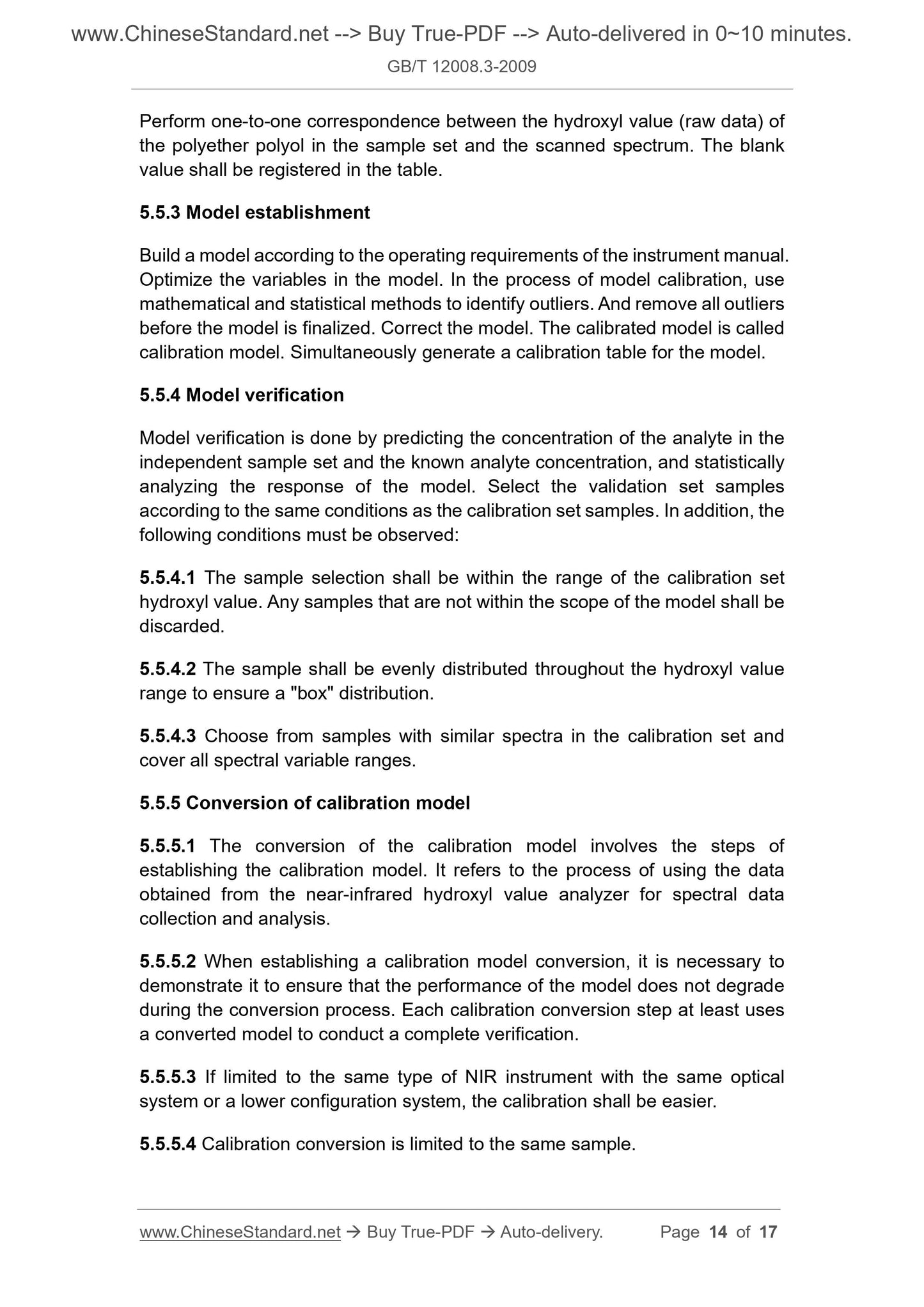1
/
of
6
www.ChineseStandard.us -- Field Test Asia Pte. Ltd.
GB/T 12008.3-2009 English PDF (GB/T12008.3-2009)
GB/T 12008.3-2009 English PDF (GB/T12008.3-2009)
Regular price
$145.00
Regular price
Sale price
$145.00
Unit price
/
per
Shipping calculated at checkout.
Couldn't load pickup availability
GB/T 12008.3-2009: Plastics -- Polyether polyols -- Part 3: Determination of hydroxyl number
Delivery: 9 seconds. Download (& Email) true-PDF + Invoice.
Get Quotation: Click GB/T 12008.3-2009 (Self-service in 1-minute)
Historical versions (Master-website): GB/T 12008.3-2009
Preview True-PDF (Reload/Scroll-down if blank)
GB/T 12008.3-2009
GB
NATIONAL STANDARD OF THE
PEOPLE’S REPUBLIC OF CHINA
ICS 83.080
G 31
Replacing GB/T 12008.3-1989
Plastics - Polyether polyols - Part 3.Determination of
hydroxyl number
(ISO 14900.2001, Plastics - Polyols for use in the production of polyurethane -
Determination of hydroxyl number, NEQ)
ISSUED ON. JUNE 15, 2009
IMPLEMENTED ON. FEBRUARY 01, 2010
Issued by. General Administration of Quality Supervision, Inspection and
Quarantine;
Standardization Administration of the People's Republic of
China.
Table of Contents
Foreword... 3
1 Scope... 5
2 Normative references... 5
3 Terms and definitions... 6
4 Method A - Phthalic anhydride method... 6
5 Method B - Near-infrared spectroscopy... 11
Annex A (informative) Precision of phthalic anhydride method... 16
Bibliography... 17
Plastics - Polyether polyols - Part 3.Determination of
hydroxyl number
Warning - The personnel using this Part shall be familiar with the routine
operation of the laboratory. This Part does not involve any security issues
related to use. If there are any problems related to the use, the user is
responsible for establishing appropriate safety and health measures and
ensuring compliance with national regulations.
1 Scope
1.1 This Part of GB/T 12008 specifies two methods for the determination of the
hydroxyl value of polyether polyols.
1.2 Method A is phthalic anhydride method. It is recommended for polyether
polyols, polymer polyols and polyols with ammonia as initiator. But for polyols
with steric hindrance, the result shall be lower. If corrective measures can be
taken, other polyols can also apply this method.
1.3 Method B specifies the determination of hydroxyl value in polyether polyols
by near infrared spectroscopy. It describes the steps of sample selection, data
collection, establishment and verification of calibration models.
2 Normative references
The provisions in following documents become the provisions of this Part of
GB/T 12008 through reference in this Part. For dated references, the
subsequent amendments (excluding corrigendum) or revisions do not apply to
this Part, however, parties who reach an agreement based on this Part are
encouraged to study if the latest versions of these documents are applicable.
For undated references, the latest edition of the referenced document applies.
GB/T 601-2002, Chemical Reagent - Preparations of Standard Volumetric
Solutions
GB/T 2035-2008, Terms and definitions for plastics (ISO 472.1999, IDT)
GB/T 6682-2008, Water for analytical laboratory use - Specification and test
methods (ISO 3696.1987, MOD)
ASTM D7253.2006, Standard Test Method for Polyurethane Raw Materials
4.5 Steps
4.5.1 Use a syringe (4.4.2) or other suitable sampling equipment to sample into
the Erlenmeyer flask (4.4.10). The mass of test material, m, is calculated by
dividing 561 by the estimated hydroxyl value, in grams.
Do not touch the sample to the bottleneck. record the mass of test material, to
the nearest of milligrams. Since the calculated mass of test material may be
close to the maximum value allowed by the method, the mass of test material
shall be close to the calculated value.
4.5.2 Accurately pipette 25mL of phthalic anhydride acylation reagent (4.3.3)
into each test material and blank Erlenmeyer flask. Shake the flask until the test
material dissolves. Each Erlenmeyer flask is connected to an air condenser
(4.4.11). Put it in the (115±2)°C oil-bath (4.4.12) for 30min.
NOTE. Some laboratories prefer to maintain the oil bath temperature at (100±2)°C. If it can
be proved that the special product can complete the quantitative reaction, then this
temperature is OK.
4.5.3 After heating, take the device out of the oil bath and cool to room
temperature. Use 30mL of pyridine (4.3.2) to rinse the condenser and remove
the condenser tube. Quantitatively transfer the solution to a 250mL beaker
(4.4.8). Use 20mL of pyridine to rinse the Erlenmeyer flask.
4.5.4 Titrate the solution in one of the following methods.
4.5.4.1 Potentiometric titration method
Place the beaker on the automatic titrator (4.4.1). Use a magnetic stirrer (4.4.3)
to stir.
Immerse the titrator electrode in the solution. Use 0.5mol/L sodium hydroxide
standard titration solution (4.3.5) to titrate to the end point. If the volume of
sodium hydroxide standard titration solution consumed for titrating the test
material is less than 80% of the blank volume, the mass of the test material is
too large. Reduce the mass of the test material and re-measure.
4.5.4.2 Colorimetric titration
Add 0.5mL phenolphthalein indicator solution (4.3.6) and magnetic stir bar.
Under stirring, use 0.5mol/L sodium hydroxide standard titration solution to
titrate to the light pink end point and keep it for 15s.
Read the volume, to the nearest of 0.02mL. If the volume of sodium hydroxide
standard titration solution consumed for titrating the sample is less than 80% of
the blank volume, the mass of the test material is too large. Reduce the mass
it is necessary to understand the chemical structure, interference, any non-
linear relationships, the influence of temperature, and the interaction of the
analyte with other components such as catalysts, moisture and other polyols,
so as to simulate these uncontrollable factors.
5.3.2.2 The calibration is only valid for the NIR instrument that specifically
generates the calibration table. Calibration and analysis using different
instruments (even manufactured by the same manufacturer) shall seriously
affect the accuracy and precision of the hydroxyl value of the test. Calling the
calibration table between instruments is problematic. These processes require
complete verification and error statistical analysis on the new instrument.
5.3.2.3 The analysis result is only statistically valid within the hydroxyl value
range used for calibration. The extrapolated hydroxyl value is too low or too
high shall increase the error and reduce the accuracy. Similarly, the analysis
results are only valid for samples of the same chemical composition used in the
calibration set. Significant changes in composition or contamination can also
affect the results. Outlier detection is a tool that can be used to detect the
possible problems mentioned above.
5.4 Selection of calibration samples
5.4.1 The samples of the calibration set shall be selected according to the
following guidelines as far as possible.
5.4.1.1 Sample selection includes all components expected to appear in the
sample of interest.
5.4.1.2 The selected sample includes a range of hydroxyl values beyond the
expected.
5.4.1.3 The hydroxyl value of the sample is evenly distributed throughout the
calibration range. Provide a "box" distribution of samples (evenly distributed
over the entire range of interest).
5.4.1.4 The number of selected samples shall be large enough to statistically
define the relationship between the spectral variables and the number of
hydroxyl values.
5.4.1.5 The spectra of all samples shall be similar to avoid wrong modeling. For
example, use the same path length for all samples; the baseline, peak
maximum, and peak minimum shall be similar.
5.4.2 The model shall eliminate all potential sources of variables that can be
eliminated during actual testing. If these sources cannot be eliminated, they
shall be included in the sample set. Sources of variables can include.
Perform one-to-one correspondence between the hydroxyl value (raw data) of
the polyether polyol in the sample set and the scanned spectrum. The blank
value shall be registered in the table.
5.5.3 Model establishment
Build a model according to the operating requirements of the instrument manual.
Optimize the variables in the model. In the process of model calibration, use
mathematical and statistical methods to identify outliers. And remove all outliers
before the model is finalized. Correct the model. The calibrated model is called
calibration model. Simultaneously generate a calibration table for the model.
5.5.4 Model verification
Model verification is done by predicting the concentration of the analyte in the
independent sample set and the known analyte concentration, and statistically
analyzing the response of the model. Select the validation set samples
according to the same conditions as the calibration set samples. In addition, the
following conditions must be observed.
5.5.4.1 The sample selection shall be within the range of the calibration set
hydroxyl value. Any samples that are not within the scope of the model shall be
discarded.
5.5.4.2 The sample shall be evenly distributed throughout the hydroxyl value
range to ensure a "box" distribution.
5.5.4.3 Choose from samples with similar spectra in the calibration set and
cover all spectral variable ranges.
5.5.5 Conversion of calibration model
5.5.5.1 The conversion of the calibration model involves the steps of
establishing the calibration model. It refers to the process of using the data
obtained from the near-infrared hydroxyl value analyzer for spectral data
collection and analysis.
5.5.5.2 When establishing a calibration model conversion, it is necessary to
demonstrate it to ensure that the performance of the model does not degrade
during the conversion process. Each calibration conversion step at least uses
a converted model to conduct a complete verification.
5.5.5.3 If limited to the same type of NIR instrument with the same optical
system or a lower configuration system, the calibration shall be easier.
5.5.5.4 Calibration conversion is limited to the same sample.
GB/T 12008.3-2009
GB
NATIONAL STANDARD OF THE
PEOPLE’S REPUBLIC OF CHINA
ICS 83.080
G 31
Replacing GB/T 12008.3-1989
Plastics - Polyether polyols - Part 3.Determination of
hydroxyl number
(ISO 14900.2001, Plastics - Polyols for use in the production of polyurethane -
Determination of hydroxyl number, NEQ)
ISSUED ON. JUNE 15, 2009
IMPLEMENTED ON. FEBRUARY 01, 2010
Issued by. General Administration of Quality Supervision, Inspection and
Quarantine;
Standardization Administration of the People's Republic of
China.
Table of Contents
Foreword... 3
1 Scope... 5
2 Normative references... 5
3 Terms and definitions... 6
4 Method A - Phthalic anhydride method... 6
5 Method B - Near-infrared spectroscopy... 11
Annex A (informative) Precision of phthalic anhydride method... 16
Bibliography... 17
Plastics - Polyether polyols - Part 3.Determination of
hydroxyl number
Warning - The personnel using this Part shall be familiar with the routine
operation of the laboratory. This Part does not involve any security issues
related to use. If there are any problems related to the use, the user is
responsible for establishing appropriate safety and health measures and
ensuring compliance with national regulations.
1 Scope
1.1 This Part of GB/T 12008 specifies two methods for the determination of the
hydroxyl value of polyether polyols.
1.2 Method A is phthalic anhydride method. It is recommended for polyether
polyols, polymer polyols and polyols with ammonia as initiator. But for polyols
with steric hindrance, the result shall be lower. If corrective measures can be
taken, other polyols can also apply this method.
1.3 Method B specifies the determination of hydroxyl value in polyether polyols
by near infrared spectroscopy. It describes the steps of sample selection, data
collection, establishment and verification of calibration models.
2 Normative references
The provisions in following documents become the provisions of this Part of
GB/T 12008 through reference in this Part. For dated references, the
subsequent amendments (excluding corrigendum) or revisions do not apply to
this Part, however, parties who reach an agreement based on this Part are
encouraged to study if the latest versions of these documents are applicable.
For undated references, the latest edition of the referenced document applies.
GB/T 601-2002, Chemical Reagent - Preparations of Standard Volumetric
Solutions
GB/T 2035-2008, Terms and definitions for plastics (ISO 472.1999, IDT)
GB/T 6682-2008, Water for analytical laboratory use - Specification and test
methods (ISO 3696.1987, MOD)
ASTM D7253.2006, Standard Test Method for Polyurethane Raw Materials
4.5 Steps
4.5.1 Use a syringe (4.4.2) or other suitable sampling equipment to sample into
the Erlenmeyer flask (4.4.10). The mass of test material, m, is calculated by
dividing 561 by the estimated hydroxyl value, in grams.
Do not touch the sample to the bottleneck. record the mass of test material, to
the nearest of milligrams. Since the calculated mass of test material may be
close to the maximum value allowed by the method, the mass of test material
shall be close to the calculated value.
4.5.2 Accurately pipette 25mL of phthalic anhydride acylation reagent (4.3.3)
into each test material and blank Erlenmeyer flask. Shake the flask until the test
material dissolves. Each Erlenmeyer flask is connected to an air condenser
(4.4.11). Put it in the (115±2)°C oil-bath (4.4.12) for 30min.
NOTE. Some laboratories prefer to maintain the oil bath temperature at (100±2)°C. If it can
be proved that the special product can complete the quantitative reaction, then this
temperature is OK.
4.5.3 After heating, take the device out of the oil bath and cool to room
temperature. Use 30mL of pyridine (4.3.2) to rinse the condenser and remove
the condenser tube. Quantitatively transfer the solution to a 250mL beaker
(4.4.8). Use 20mL of pyridine to rinse the Erlenmeyer flask.
4.5.4 Titrate the solution in one of the following methods.
4.5.4.1 Potentiometric titration method
Place the beaker on the automatic titrator (4.4.1). Use a magnetic stirrer (4.4.3)
to stir.
Immerse the titrator electrode in the solution. Use 0.5mol/L sodium hydroxide
standard titration solution (4.3.5) to titrate to the end point. If the v...
Delivery: 9 seconds. Download (& Email) true-PDF + Invoice.
Get Quotation: Click GB/T 12008.3-2009 (Self-service in 1-minute)
Historical versions (Master-website): GB/T 12008.3-2009
Preview True-PDF (Reload/Scroll-down if blank)
GB/T 12008.3-2009
GB
NATIONAL STANDARD OF THE
PEOPLE’S REPUBLIC OF CHINA
ICS 83.080
G 31
Replacing GB/T 12008.3-1989
Plastics - Polyether polyols - Part 3.Determination of
hydroxyl number
(ISO 14900.2001, Plastics - Polyols for use in the production of polyurethane -
Determination of hydroxyl number, NEQ)
ISSUED ON. JUNE 15, 2009
IMPLEMENTED ON. FEBRUARY 01, 2010
Issued by. General Administration of Quality Supervision, Inspection and
Quarantine;
Standardization Administration of the People's Republic of
China.
Table of Contents
Foreword... 3
1 Scope... 5
2 Normative references... 5
3 Terms and definitions... 6
4 Method A - Phthalic anhydride method... 6
5 Method B - Near-infrared spectroscopy... 11
Annex A (informative) Precision of phthalic anhydride method... 16
Bibliography... 17
Plastics - Polyether polyols - Part 3.Determination of
hydroxyl number
Warning - The personnel using this Part shall be familiar with the routine
operation of the laboratory. This Part does not involve any security issues
related to use. If there are any problems related to the use, the user is
responsible for establishing appropriate safety and health measures and
ensuring compliance with national regulations.
1 Scope
1.1 This Part of GB/T 12008 specifies two methods for the determination of the
hydroxyl value of polyether polyols.
1.2 Method A is phthalic anhydride method. It is recommended for polyether
polyols, polymer polyols and polyols with ammonia as initiator. But for polyols
with steric hindrance, the result shall be lower. If corrective measures can be
taken, other polyols can also apply this method.
1.3 Method B specifies the determination of hydroxyl value in polyether polyols
by near infrared spectroscopy. It describes the steps of sample selection, data
collection, establishment and verification of calibration models.
2 Normative references
The provisions in following documents become the provisions of this Part of
GB/T 12008 through reference in this Part. For dated references, the
subsequent amendments (excluding corrigendum) or revisions do not apply to
this Part, however, parties who reach an agreement based on this Part are
encouraged to study if the latest versions of these documents are applicable.
For undated references, the latest edition of the referenced document applies.
GB/T 601-2002, Chemical Reagent - Preparations of Standard Volumetric
Solutions
GB/T 2035-2008, Terms and definitions for plastics (ISO 472.1999, IDT)
GB/T 6682-2008, Water for analytical laboratory use - Specification and test
methods (ISO 3696.1987, MOD)
ASTM D7253.2006, Standard Test Method for Polyurethane Raw Materials
4.5 Steps
4.5.1 Use a syringe (4.4.2) or other suitable sampling equipment to sample into
the Erlenmeyer flask (4.4.10). The mass of test material, m, is calculated by
dividing 561 by the estimated hydroxyl value, in grams.
Do not touch the sample to the bottleneck. record the mass of test material, to
the nearest of milligrams. Since the calculated mass of test material may be
close to the maximum value allowed by the method, the mass of test material
shall be close to the calculated value.
4.5.2 Accurately pipette 25mL of phthalic anhydride acylation reagent (4.3.3)
into each test material and blank Erlenmeyer flask. Shake the flask until the test
material dissolves. Each Erlenmeyer flask is connected to an air condenser
(4.4.11). Put it in the (115±2)°C oil-bath (4.4.12) for 30min.
NOTE. Some laboratories prefer to maintain the oil bath temperature at (100±2)°C. If it can
be proved that the special product can complete the quantitative reaction, then this
temperature is OK.
4.5.3 After heating, take the device out of the oil bath and cool to room
temperature. Use 30mL of pyridine (4.3.2) to rinse the condenser and remove
the condenser tube. Quantitatively transfer the solution to a 250mL beaker
(4.4.8). Use 20mL of pyridine to rinse the Erlenmeyer flask.
4.5.4 Titrate the solution in one of the following methods.
4.5.4.1 Potentiometric titration method
Place the beaker on the automatic titrator (4.4.1). Use a magnetic stirrer (4.4.3)
to stir.
Immerse the titrator electrode in the solution. Use 0.5mol/L sodium hydroxide
standard titration solution (4.3.5) to titrate to the end point. If the volume of
sodium hydroxide standard titration solution consumed for titrating the test
material is less than 80% of the blank volume, the mass of the test material is
too large. Reduce the mass of the test material and re-measure.
4.5.4.2 Colorimetric titration
Add 0.5mL phenolphthalein indicator solution (4.3.6) and magnetic stir bar.
Under stirring, use 0.5mol/L sodium hydroxide standard titration solution to
titrate to the light pink end point and keep it for 15s.
Read the volume, to the nearest of 0.02mL. If the volume of sodium hydroxide
standard titration solution consumed for titrating the sample is less than 80% of
the blank volume, the mass of the test material is too large. Reduce the mass
it is necessary to understand the chemical structure, interference, any non-
linear relationships, the influence of temperature, and the interaction of the
analyte with other components such as catalysts, moisture and other polyols,
so as to simulate these uncontrollable factors.
5.3.2.2 The calibration is only valid for the NIR instrument that specifically
generates the calibration table. Calibration and analysis using different
instruments (even manufactured by the same manufacturer) shall seriously
affect the accuracy and precision of the hydroxyl value of the test. Calling the
calibration table between instruments is problematic. These processes require
complete verification and error statistical analysis on the new instrument.
5.3.2.3 The analysis result is only statistically valid within the hydroxyl value
range used for calibration. The extrapolated hydroxyl value is too low or too
high shall increase the error and reduce the accuracy. Similarly, the analysis
results are only valid for samples of the same chemical composition used in the
calibration set. Significant changes in composition or contamination can also
affect the results. Outlier detection is a tool that can be used to detect the
possible problems mentioned above.
5.4 Selection of calibration samples
5.4.1 The samples of the calibration set shall be selected according to the
following guidelines as far as possible.
5.4.1.1 Sample selection includes all components expected to appear in the
sample of interest.
5.4.1.2 The selected sample includes a range of hydroxyl values beyond the
expected.
5.4.1.3 The hydroxyl value of the sample is evenly distributed throughout the
calibration range. Provide a "box" distribution of samples (evenly distributed
over the entire range of interest).
5.4.1.4 The number of selected samples shall be large enough to statistically
define the relationship between the spectral variables and the number of
hydroxyl values.
5.4.1.5 The spectra of all samples shall be similar to avoid wrong modeling. For
example, use the same path length for all samples; the baseline, peak
maximum, and peak minimum shall be similar.
5.4.2 The model shall eliminate all potential sources of variables that can be
eliminated during actual testing. If these sources cannot be eliminated, they
shall be included in the sample set. Sources of variables can include.
Perform one-to-one correspondence between the hydroxyl value (raw data) of
the polyether polyol in the sample set and the scanned spectrum. The blank
value shall be registered in the table.
5.5.3 Model establishment
Build a model according to the operating requirements of the instrument manual.
Optimize the variables in the model. In the process of model calibration, use
mathematical and statistical methods to identify outliers. And remove all outliers
before the model is finalized. Correct the model. The calibrated model is called
calibration model. Simultaneously generate a calibration table for the model.
5.5.4 Model verification
Model verification is done by predicting the concentration of the analyte in the
independent sample set and the known analyte concentration, and statistically
analyzing the response of the model. Select the validation set samples
according to the same conditions as the calibration set samples. In addition, the
following conditions must be observed.
5.5.4.1 The sample selection shall be within the range of the calibration set
hydroxyl value. Any samples that are not within the scope of the model shall be
discarded.
5.5.4.2 The sample shall be evenly distributed throughout the hydroxyl value
range to ensure a "box" distribution.
5.5.4.3 Choose from samples with similar spectra in the calibration set and
cover all spectral variable ranges.
5.5.5 Conversion of calibration model
5.5.5.1 The conversion of the calibration model involves the steps of
establishing the calibration model. It refers to the process of using the data
obtained from the near-infrared hydroxyl value analyzer for spectral data
collection and analysis.
5.5.5.2 When establishing a calibration model conversion, it is necessary to
demonstrate it to ensure that the performance of the model does not degrade
during the conversion process. Each calibration conversion step at least uses
a converted model to conduct a complete verification.
5.5.5.3 If limited to the same type of NIR instrument with the same optical
system or a lower configuration system, the calibration shall be easier.
5.5.5.4 Calibration conversion is limited to the same sample.
GB/T 12008.3-2009
GB
NATIONAL STANDARD OF THE
PEOPLE’S REPUBLIC OF CHINA
ICS 83.080
G 31
Replacing GB/T 12008.3-1989
Plastics - Polyether polyols - Part 3.Determination of
hydroxyl number
(ISO 14900.2001, Plastics - Polyols for use in the production of polyurethane -
Determination of hydroxyl number, NEQ)
ISSUED ON. JUNE 15, 2009
IMPLEMENTED ON. FEBRUARY 01, 2010
Issued by. General Administration of Quality Supervision, Inspection and
Quarantine;
Standardization Administration of the People's Republic of
China.
Table of Contents
Foreword... 3
1 Scope... 5
2 Normative references... 5
3 Terms and definitions... 6
4 Method A - Phthalic anhydride method... 6
5 Method B - Near-infrared spectroscopy... 11
Annex A (informative) Precision of phthalic anhydride method... 16
Bibliography... 17
Plastics - Polyether polyols - Part 3.Determination of
hydroxyl number
Warning - The personnel using this Part shall be familiar with the routine
operation of the laboratory. This Part does not involve any security issues
related to use. If there are any problems related to the use, the user is
responsible for establishing appropriate safety and health measures and
ensuring compliance with national regulations.
1 Scope
1.1 This Part of GB/T 12008 specifies two methods for the determination of the
hydroxyl value of polyether polyols.
1.2 Method A is phthalic anhydride method. It is recommended for polyether
polyols, polymer polyols and polyols with ammonia as initiator. But for polyols
with steric hindrance, the result shall be lower. If corrective measures can be
taken, other polyols can also apply this method.
1.3 Method B specifies the determination of hydroxyl value in polyether polyols
by near infrared spectroscopy. It describes the steps of sample selection, data
collection, establishment and verification of calibration models.
2 Normative references
The provisions in following documents become the provisions of this Part of
GB/T 12008 through reference in this Part. For dated references, the
subsequent amendments (excluding corrigendum) or revisions do not apply to
this Part, however, parties who reach an agreement based on this Part are
encouraged to study if the latest versions of these documents are applicable.
For undated references, the latest edition of the referenced document applies.
GB/T 601-2002, Chemical Reagent - Preparations of Standard Volumetric
Solutions
GB/T 2035-2008, Terms and definitions for plastics (ISO 472.1999, IDT)
GB/T 6682-2008, Water for analytical laboratory use - Specification and test
methods (ISO 3696.1987, MOD)
ASTM D7253.2006, Standard Test Method for Polyurethane Raw Materials
4.5 Steps
4.5.1 Use a syringe (4.4.2) or other suitable sampling equipment to sample into
the Erlenmeyer flask (4.4.10). The mass of test material, m, is calculated by
dividing 561 by the estimated hydroxyl value, in grams.
Do not touch the sample to the bottleneck. record the mass of test material, to
the nearest of milligrams. Since the calculated mass of test material may be
close to the maximum value allowed by the method, the mass of test material
shall be close to the calculated value.
4.5.2 Accurately pipette 25mL of phthalic anhydride acylation reagent (4.3.3)
into each test material and blank Erlenmeyer flask. Shake the flask until the test
material dissolves. Each Erlenmeyer flask is connected to an air condenser
(4.4.11). Put it in the (115±2)°C oil-bath (4.4.12) for 30min.
NOTE. Some laboratories prefer to maintain the oil bath temperature at (100±2)°C. If it can
be proved that the special product can complete the quantitative reaction, then this
temperature is OK.
4.5.3 After heating, take the device out of the oil bath and cool to room
temperature. Use 30mL of pyridine (4.3.2) to rinse the condenser and remove
the condenser tube. Quantitatively transfer the solution to a 250mL beaker
(4.4.8). Use 20mL of pyridine to rinse the Erlenmeyer flask.
4.5.4 Titrate the solution in one of the following methods.
4.5.4.1 Potentiometric titration method
Place the beaker on the automatic titrator (4.4.1). Use a magnetic stirrer (4.4.3)
to stir.
Immerse the titrator electrode in the solution. Use 0.5mol/L sodium hydroxide
standard titration solution (4.3.5) to titrate to the end point. If the v...
Share
